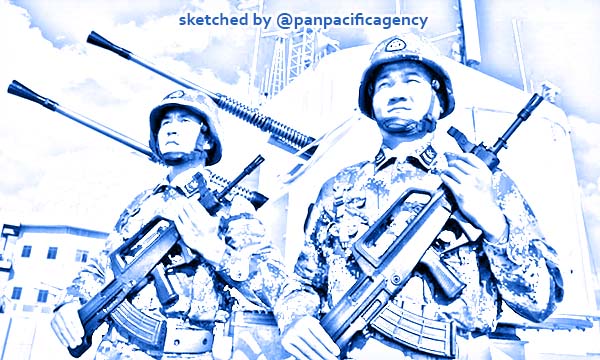[Analytics] ASEAN in the driver’s seat in the South China Sea

Chinese PLA Navy soldiers on a naval vessel in the South China Sea. Photo: Twitter. Sketched by the Pan Pacific Agency.
On 6 May 2009, Malaysia and Vietnam jointly notified a submission to the UN Commission on the Limits of the Continental Shelf (CLCS). The submission implicitly declared that the Spratly islands were incapable of generating entitlements beyond their 12 nautical mile territorial sea limit. Sourabh Gupta specially for the East Asia Forum.
China shot back a diplomatic note the next day with an attached nine-dash line map, provoking a blizzard of counter-diplomatic notes. US Secretary of State Hillary Clinton rode the ensuing dust-up to the Hanoi-chaired ASEAN Regional Forum (ARF) meeting in July 2010 where 12 of the group’s 27 members — including five ASEAN countries — singled Beijing out for its deplorable conduct in the South China Sea.
Ten years later, on 12 December 2019, Malaysia submitted another notification — this time implicitly declaring that the Paracel Islands were also incapable of generating entitlements beyond 12 nautical miles. The ensuing correspondence drew Australia, France, Germany and the United Kingdom into the fray. Even tiny Brunei chimed in. The script somehow went awry after that.
US Secretary of State Mike Pompeo’s attempt to ride the tensions to their logical anti-China denouement at the (once again) Hanoi-chaired ARF meeting was greeted with resolute pushback by ASEAN’s ‘balancing’ states — Indonesia and Singapore. More pointedly, the conservative Japanese and pro-US daily, the Yomiuri, editorialised that the United States needed to foster regional peace rather ‘than try to drive wedges between China and related Southeast Asian nations’.
So what gave? And what are the key insights that can be gleaned for 2021?
First, ASEAN and China continue to view the post-arbitration period as a moment of strategic opportunity in their South China Sea relations. This is due largely to the turnaround in China–Philippines relations. ASEAN’s loose consensus on the issue has — at the margin — been guided by the pendulum swings in Manila’s China policy over the past two decades.
China has for its part played nice, abiding by the Philippines’ red lines. It has not reclaimed additional land in the South China Sea, occupied any new feature or territory, or built structures on Scarborough Shoal. It no longer interferes with Philippine resupply missions to the latter’s grounded vessel on Second Thomas Shoal.
Concerning oil and gas exploitation on the Philippines’ continental shelf, Beijing has eschewed unilateralism and instead crafted a farsighted ‘cooperative development’ arrangement. This arrangement implicitly acknowledges Manila’s exclusive sovereign rights and jurisdiction, hews to the national patrimony clause of the Philippine constitution, and is consistent with the Arbitration Award. It also breathes life into the joint development principle that Deng Xiaoping had proposed to Philippine leaders in the late-1980s.
Over misconduct by its fishermen in Philippine waters, China — or rather China’s Guangdong Fishery Mutual Insurance Association — even went so far as to tender an unusual apology in August 2019. The enabling role played by Philippine President Rodrigo Duterte in suspending implementation of the Arbitration Award and limiting Manila’s South China Sea-facing bilateral exercises to the 12 nautical mile limit should not be diminished.
Second, every prior cycle of deteriorating ASEAN–China relations (1992–1998 and 2009–2016) in the South China Sea has also been inaugurated by Beijing’s issuance of a controversial maritime rights claim. This time, China has barely mentioned the nine-dash line. On the one occasion when it did mention the ‘dotted line’, it did so to clarify and limit — not amplify — its claim in these waters. On the other hand, Chinese vessels have brazenly conducted illegal survey activity on Vietnam’s and Malaysia’s continental shelf in 2019 and 2020. Beijing does not enjoy a basis in international law to do so and must rein in its vessels.
Still, if Beijing can extend its ‘cooperative development’ model to Kuala Lumpur and Hanoi, it will effectively take the sting out of these sovereignty-linked disputes. It will also invalidate the premise that China claims exclusive sovereign rights and jurisdiction in its counterparts’ EEZs — by which the arbitrators struck down the nine-dash line in 2016.
Finally, the United States has never held as hard-line an anti-China (and pro-ASEAN claimant state) diplomatic and military stance on the South China Sea over the past three decades, yet reaped as few dividends among regional states as it did in 2020. It is true that ASEAN is loath to choose sides. It is equally true that during a period of strategic opportunity in China–ASEAN ties, the United States will never find an agitated enough local claimant whose interests Washington could commandeer to assert its own relevance in this body of water beyond the occasional FONOP and the token visa restrictions and export controls.
Washington’s problematic reconnaissance practices, on the other hand, could provoke Beijing to establish an air defence identification zone (ADIZ). The zone’s dimension could correspond to the ICAO-regulated Sanya flight information region (FIR) and cover the Paracel Islands — much like Japan’s ADIZ in the East China Sea tracks the Fukuoka FIR and covers the Senkakus.
Matters could yet go south in the South China Sea in 2021. The Philippines–China oil and gas arrangement could get suspended like its Japan–China counterpart. Hanoi could haul Beijing to international court to clarify its resource rights. Beijing’s brinksmanship in the Code of Conduct (CoC) negotiations could provoke Manila to internationalise the Hague ruling. The CoC negotiations could exacerbate differences beyond those between China and ASEAN. The Biden team also remains an unknown quantity.
On balance though, there is more to hope for than fear.
Sourabh Gupta is resident senior fellow at the Institute for China-America Studies, Washington DC.